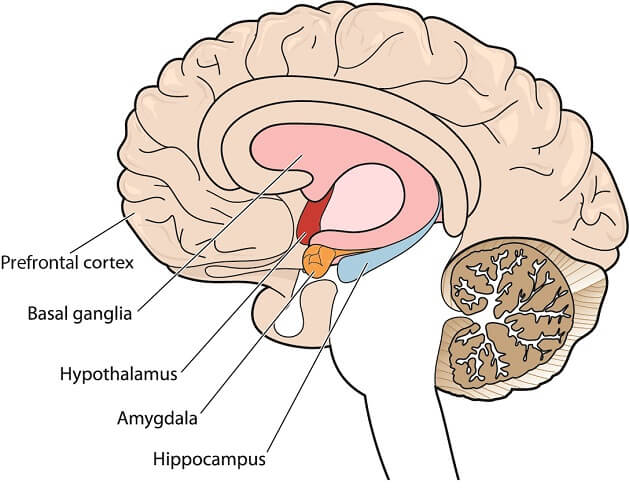Definition
Explicit memory, also known as declarative memory, is one of the major subsets of long-term memory in humans. The other type of long-term memory is called implicit or non-declarative memory.
Explicit memory refers to a system of storage and recall of conscious memories. It is sometimes called ‘declarative’ because it can be recalled and communicated intentionally or voluntarily.
Examples include recalling what occurred during an event, remembering facts and details, and recalling and understanding concepts. If you are visiting this article as part of your studies, you’re probably trying to exercise your explicit memory right now!

Explicit Memory vs. Implicit Memory
Explicit and implicit memory are two types of long-term memory. Whereas explicit memory refers to conscious memories, implicit memory is unconscious, or procedural memory. Implicit memory includes the ability to carry out tasks, respond to stimuli, and make associations between stimuli. You cannot necessarily consciously recall this type of information. For instance, it is difficult to explain how you ride a bike, you just do it. It is more automatic.
To learn more, visit our article that compares implicit and explicit memories.
Types and Examples of Explicit Memory
Explicit memory can be divided into two broad categories: episodic memory and semantic memory, which define the type of information being stored. The distinction between these categories is not entirely strict, and there is likely considerable interaction between the two systems.
Other classes of explicit memory – such as autobiographical and spatial memory – are sometimes also designated their own categories.
Episodic Memory
Episodic memory refers to the storage and recollection of first-hand personal experiences. Examples include being able to recall a sequence of events that occurred during a particular occasion, where and when that occasion took place, as well as details like what you were wearing and what you had for lunch that day.
Usually, episodic memories are more vivid if the event attached to them was significant. For example, many people will be able to recall where they were when they learned of the unexpected death of Michael Jackson.
Semantic Memory
Semantic memory refers to the process of storing factual information. This information can, like episodic memory, be voluntarily articulated, and includes facts and figures, definitions, and concepts. For example, “the capital of Italy is Rome,” “the mitochondrion is the powerhouse of the cell,” and “explicit memory refers to conscious memories.”
Autobiographical Memory
Autobiographical memory is a combination of episodic and semantic memories. It is often confused with episodic memory, but research suggests they are part of different systems. Autobiographical memory occurs over a longer time than episodic memory. It is thought to be the consolidation of events that have happened throughout our lives, giving us an impression of who we are as a person. It is inherently ‘human.’
Spatial Memory
Spatial memory refers to a person’s awareness of their surroundings, i.e., their ability to navigate their way around an area. For example, it is because of spatial memory that you can find your way around your home town and recall where different regions are in comparison to one another.

Explicit Memory and the Brain
The main areas of the brain involved in storing explicit memories are the hippocampus, the prefrontal cortex, and the amygdala.
Hippocampus
The hippocampus is an S-shaped neuronal structure that is found deep within the temporal lobe of the brain. The hippocampus is implicated in learning, memory consolidation, and spatial navigation. It is thought to be particularly important in the formation of new explicit memories. Damage or atrophy affecting the hippocampus primarily inhibits the formation of new memories, but can also damage the recollection of older memories.
Prefrontal Cortex
The prefrontal cortex covers part of the frontal lobe of the brain and is implicated in personality, decision-making, and social behaviors. It is also thought to be involved in the retrieval of explicit memories, particularly those relating to speech and semantic memory. The prefrontal cortex works together with the hippocampus to create long term storage of these memories.
Amygdalae
The amygdalae are a pair of two almond-shaped structures (singular – amygdala) located deep within the brain. They are found close to – and also work closely with – the hippocampus. The primary role of the amygdalae is in regulating emotions, such as anger and fear, and decision-making.
However, the amygdalae also have an important role in memory through their role in emotional learning. When there is a strong emotional component to an event, it is more likely to be consolidated into long-term memory. For example, you probably don’t remember what you were doing on the morning of May 4th, 2003, but you will likely remember what you were doing on the morning of September 11th, 2001.

Clinical Relevance
Alzheimer’s Disease
Alzheimer’s disease accounts for well over half of all cases of dementia worldwide. The disorder is characterized by chronic neurodegeneration, reflected in progressive worsening of explicit memory. The deterioration of this type of memory is usually the first sign of Alzheimer’s disease and related disorders.
Alzheimer’s disease is caused by the formation of protein aggregates called amyloid plaques in the brain. These plaques kill neurons and cause damage to the areas of the brain in which they are found. The hippocampus is often one of the first and most severely affected structures in Alzheimer’s disease.
Anterograde Amnesia
Anterograde amnesia describes the inability to form and recall new memories after a particular event, such as a brain injury or a traumatic event. Long-term memories remain intact, but memories surrounding the event and future memories are not retained. Acute anterograde amnesia is also caused by the use of certain drugs and alcohol intoxication.
Usually, implicit memory is retained in patients with anterograde amnesia, so they can still recall how to perform tasks and learn new ones. For example, patients with anterograde amnesia can often learn how to play a musical instrument. However, they have lost their ability to recall facts and events.
The Case of Henry Molaison
Henry Molaison suffered from epileptic fits since childhood. By his mid-twenties, the disorder was so debilitating he could no longer lead a normal life. In 1953, in an attempt to treat his epilepsy, doctors performed a lobotomy. In doing so, they removed some critical structures in his brain including the hippocampus, parahippocampus, and amygdalae.
This procedure rendered him entirely unable to form new memories, a severe form of anterograde amnesia. His implicit memory was intact, as he could learn how to perform new tasks. However, his explicit memory was dysfunctional; he could not retain any new information.
Henry Molaison was subject to intense research for the remainder of his life, and even after his death. He is well-known as “H.M.” in the neuroscience research community, and his full name was not made public until after his death. His very sad experience revolutionized the understanding of how parts of the brain control memory.
Quiz
